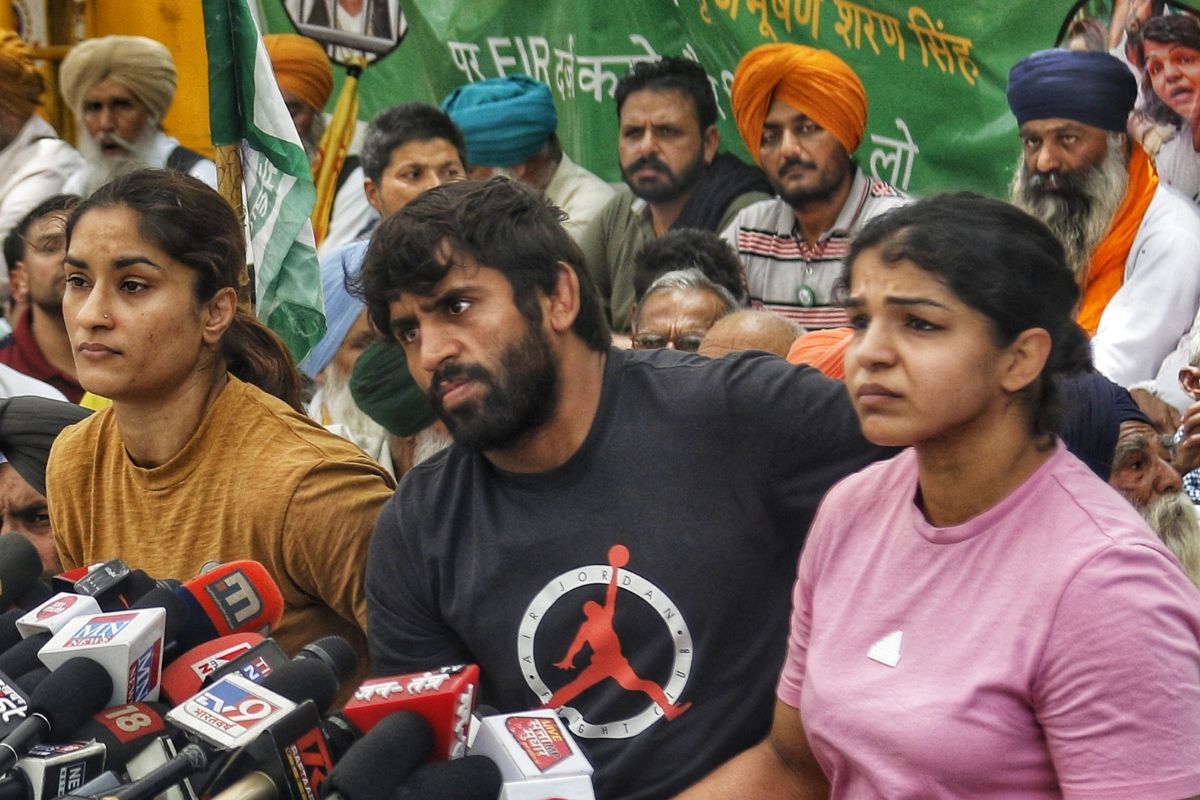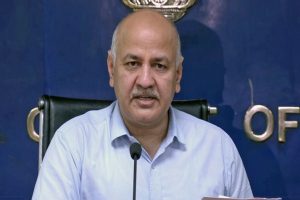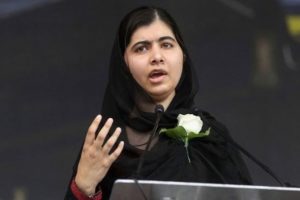At last, thankfully, the Government seems to be listening to the women wrestlers, protesting against molestation by the erstwhile President of the Wrestling Federation of India (WFI). The wrestlers’ agitation has focused an unflattering spotlight on the shining façade of Indian sports, which has, sadly, revealed a thoroughly rotten interior. It would appear that most sports associations are run as personal fiefdoms of powerful politicians and bureaucrats, for example, the WFI, existed as a one-man federation.
The President doubled as the selection committee chief, as also chairman of the athletes’ grievance panel – giving him single-handed control of the federation. Then, most sports bodies practise the worst form of patriarchy, have no concept of gender justice, and function without the mandatory Prevention of Sexual Harassment (POSH) Committees, leaving athletes with no forum to report harassment.
Advertisement
The eagerness of unprincipled persons to associate themselves with sports can probably be understood, in the perspective of the massive corruption unearthed in Commonwealth Games 2010. Unfortunately, the Sports ministry, does little beyond mouthing platitudes, and providing funds to maintain the lop-sided status quo.
The wrestlers’ protests, which took place in full public view, with twenty-four hour media coverage, raised the larger question of entitlement of the powerful. One would think that lodging a First Information Report (FIR) is a right of every citizen, but the wrestlers had to sit and sleep in the open for days together, and approach the Supreme Court to get FIRs lodged for molestation and crimes under the Protection of Children from Sexual Offences Act ~ only because the alleged culprit is an MP of the ruling party.
Then, even after coverage by international media and considerable support by sportspersons and civil society, the police dragged their feet over carrying out meaningful investigation. It was only after the agitation threatened to have unfavourable political repercussions that ministers of the government agreed to listen to the wrestlers.
According to his election affidavit, the person against whom the wrestlers’ protest is directed, had 38 criminal cases lodged against him between 1974 and 2007, including FIRs under the Gangsters and Goonda Acts for various offences like theft, dacoity, murder, criminal intimidation, attempt to murder, and kidnapping. This list also includes a case under TADA, for allegedly helping associates of Dawood Ibrahim in the JJ Hospital shootout in Mumbai. Again, as per his election affidavit, he has been acquitted in the TADA case and most other cases.
During the entire episode, the accused appeared unfazed and unrepentant, matching the wrestlers’ allegations with allegations of his own. The accused went to the extent of discrediting medals won at the Olympics and other prestigious tournaments as ‘Rs 15 baubles.’ Attempts were made to portray the protest as a political dispute, orchestrated by opposition parties. A Haryana (to which the wrestlers belong) vs. UP (to which the accused belongs) twist was also attempted to be given.
Trolls mounted a disinformation campaign, going to the extent of circulating morphed photos of lady wrestlers. Simultaneously, a number of videos and social media posts, questioning the character and bonafides of the wrestlers, proliferated. A public rally was proposed, by the accused’s supporters, against the POCSO Act, which was cancelled. However, recently, the accused held a huge rally and a twenty-five-kilometre-long roadshow in his Parliamentary constituency. Whichever way the wrestlers’ agitation is resolved, the can of worms opened by the agitation would continue to bedevil Indian sports for a long time.
The governing body of wrestling, United World Wrestling (UWW ), has taken adverse note of the Government’s response to the wrestlers’ agitation: “UWW firmly condemns the treatment and detention of the wrestlers. It expresses its disappointment over the lack of results of the investigations so far…” UWW threatened WFI with suspension, should WFI fail to hold elections in time, which would force the athletes “to compete under a neutral flag.”
Around half a century ago, when the bulk of sports associations were formed, most sports had no mass base in India, TV was limited to Delhi and only amateurs were allowed to compete in sports. India had no world-level female sportspersons. Even for men, except for hockey, only some privileged few competed, desultorily, in sports and games. Sports associations were manned by minor princelings, or Collectors and SPs, who did not have much interest in sports but had associated themselves with sports for photo-ops, or the occasional visit abroad.
Now, with proliferation of TV and internet, people in the remotest village are aware of the finer points of all popular sports and games; budding athletes hone their skills by watching TV and YouTube. Sports academies that teach shooting, wrestling, boxing etc. have proliferated in the hinterlands, bringing millions of not-so-rich boys and girls into the sporting mainstream. Big bucks in sports are an added incentive.
With such a vast pool of talent, and the considerable monetary incentives, Indian sportspersons are beginning to be noticed internationally. Unfortunately, the change in the sports ecosystem is not reflected in the way sports are administered, and it would appear that Indian sportspersons are doing well by their own efforts, despite the machinations of sports administrators. In any case, national level sports associations come on the scene only after an athlete has gained recognition.
Probably, sports associations could do better to spot and encourage sportspersons competing at college and district level. Also, the nascent upsurge in sports can be supported by making sports compulsory in schools and having a sports ground attached to all schools, which will also enhance fitness in schoolchildren and balance the curriculum. National Education Policy (NEP) 2020 envisages sports as a part of the curriculum, and lays emphasis on sports-integrated learning, but there is no sign of implementation of this directive. Finally, kinks in sports administration are a global malaise. Nadia Comaneci, an all-time great gymnast, who was the first to score a perfect of 10 at the Olympics, and who won three gold medals at the Montreal Olympics at 14 years of age, was ruthlessly exploited by the Romanian dictator’s son, Nicu Ceausescu. The USA Gymnastics (USAG) sex abuse scandal that came to trial in 2017, relates to the sexual abuse of 368 gymnasts ~ most of them minors at the time of abuse ~ for over two decades.
The abusers were gym owners, coaches, and staff working for gymnastics programs across the US. Long-time USAG national team doctor Larry Nassar, was named, in hundreds of lawsuits filed by athletes, who alleged that Nassar engaged in sexual abuse for at least 14 years, under the pretence of providing medical treatment. More than 265 women have accused Nassar of sexually assaulting them. It is considered the largest sexual abuse scandal in sports history.
Nassar has pleaded guilty to federal child pornography charges, and has been sentenced to hundreds of years in jail, in various lawsuits. John Geddert, the coach of the US gymnastics team that won the gold-medal in 2012, was charged with various offences including sexual assault, abuse of minors and human trafficking. Geddert committed suicide, before his case came up for trial. Sexual abuse of athletes was not confined to gymnastics alone; more than 290 coaches and officials, associated with more than 15 American Olympic sports organizations, have been publicly accused of sexual misconduct between 1982 and 2017.
This figure includes more than 175 officials convicted of sex crimes, as well as some who never faced criminal charges, and have denied claims. After such massive scandals, the US passed the Protecting Young Victims from Sexual Abuse and Safe Sport Authorization Act, in 2017.
Consequently, the United States Olympic & Paralympic Committee, established the US Center for SafeSport, an independent non-profit organization responsible for responding to, and preventing emotional, physical, and sexual misconduct and abuse. SafeSport has put in place an extensive Athletes’ Safety Policy.
SafeSport also runs a 24X7 helpline, and accepts complaints (even anonymous ones) online, and by email or phone. All US sports associations have a similar set-up. Sadly, similar abuse of sportspersons has been reported in all sports, across all sporting nations.
Following the US example, many countries have put in place, systems that prevent such incidents, combined with a defined procedure of reporting sexual abuse, that exposes the abuser and brings him to book. It is high time that similar reforms are initiated in India. Otherwise, no self-respecting parent will send his talented child in the world of sports, thus derailing the Indian desire of becoming a sporting superpower.
(The writer is a retired Principal Chief Commissioner of Income-Tax)











